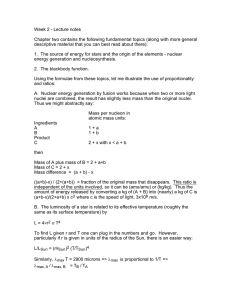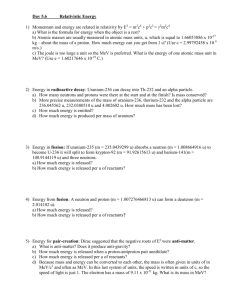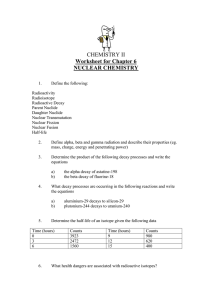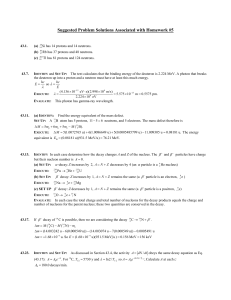The answers to these and many other questions are
advertisement
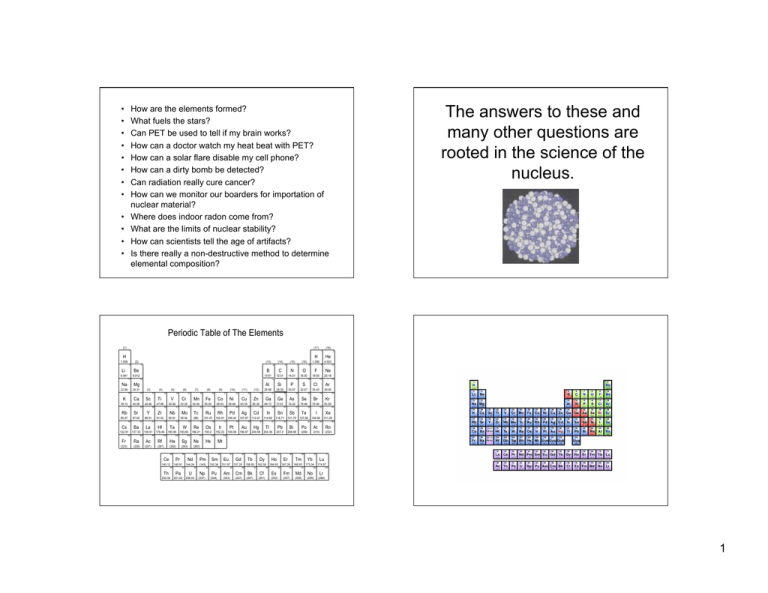
•
•
•
•
•
•
•
•
The answers to these and
many other questions are
rooted in the science of the
nucleus.
How are the elements formed?
What fuels the stars?
Can PET be used to tell if my brain works?
How can a doctor watch my heat beat with PET?
How can a solar flare disable my cell phone?
How can a dirty bomb be detected?
Can radiation really cure cancer?
How can we monitor our boarders for importation of
nuclear material?
Where does indoor radon come from?
What are the limits of nuclear stability?
How can scientists tell the age of artifacts?
Is there really a non-destructive method to determine
elemental composition?
•
•
•
•
Periodic Table of The Elements
(1)
(17)
(18)
1
1
H
1.008
(2)
(13)
3
(14)
4
(15)
(16)
6
5
7
2
H
He
1.008
4.003
8
9
10
Li
Be
B
C
N
O
F
Ne
6.941
9.012
10.81
12.01
14.01
16.00
19.00
20.18
11
Na
12
13
Mg
22.99
14
Al
24.31
19
(3)
20
(4)
(5)
21
(6)
22
(7)
23
(8)
24
(9)
25
(10)
26
(11)
27
28
(12)
29
15
Si
26.98
30
16
P
28.09
31
17
S
30.97
32
18
Cl
32.07
Ar
35.45
33
39.95
34
35
36
K
Ca
Sc
Ti
V
Cr
Mn
Fe
Co
Ni
Cu
Zn
Ga
Ge
As
Se
Br
Kr
39.10
40.08
44.96
47.88
50.94
52.00
54.94
55.85
58.93
58.69
63.55
65.39
69.72
72.61
74.92
78.96
79.90
83.80
37
Rb
38
Sr
85.47
39
Y
87.62
55
40
41
Zr
88.91
56
42
Nb
91.22
43
Mo
92.91
57
44
Tc
95.94
72
45
Ru
(98)
73
46
Rh
101.07
74
75
47
Pd
102.91
76
48
Ag
106.42
77
49
Cd
107.87
78
50
In
112.41
79
Sn
114.82
80
51
52
Sb
118.71
81
53
Te
121.75
82
54
I
127.60
83
Xe
126.90
84
131.29
85
86
Cs
Ba
La
Hf
Ta
W
Re
Os
Ir
Pt
Au
Hg
Tl
Pb
Bi
Po
At
Rn
132.91
137.33
138.91
178.49
180.95
183.85
186.21
190.2
192.22
195.08
196.97
200.59
204.38
207.2
208.98
(209)
(210)
(222)
87
88
89
104
105
106
107
Fr
Ra
Ac
Rf
Ha
Sg
Ns
(223)
(226)
(227)
(261)
(262)
(263)
(262)
58
Ce
59
Pr
140.12
60
Nd
140.91
90
108
Hs
61
Pm
144.24
91
109
Mt
62
Sm
(145)
92
63
Eu
150.36
93
64
Gd
151.97
94
65
Tb
157.25
95
66
Dy
158.93
96
67
Ho
162.50
97
68
Er
164.93
98
99
167.26
100
69
70
Tm
Yb
168.93
173.04
101
71
Lu
174.97
102
103
Th
Pa
U
Np
Pu
Am
Cm
Bk
Cf
Es
Fm
Md
No
Lr
232.04
231.04
238.03
(237)
(244)
(243)
(247)
(247)
(251)
(252)
(257)
(258)
(259)
(260)
1
N=Z
Z
N
the players
particle
mass
charge
electrons
positrons
gamma rays
neutrinos
511KeV
511KeV
0
0
-1
+1
0
0
1/2
1/2
1
1/2
1.00866amu
1.00728amu
0
+1
1/2
1/2
+2
0
nucleons
neutrons
protons
Nuclear stability
spin
leptons
•
•
•
•
valley of stability - stable isotopes
Even-Even : most stable
Odd-Even (or Even-Odd) : somewhat stable
Odd-Odd : 4 known stable
nuclei
alpha particles
4.0026amu
fission fragments
2
Beta Decay
• β- decay (n->p)
• 16N -> 16O + β- + ν
©2010, 2008, 2005, 2002 by P. W.
Atkins and L. L. Jones
Beta Decay
• positron decay (p->n)
• 18F -> 18O + β+ + ν ©2010, 2008, 2005, 2002 by P. W.
Atkins and L. L. Jones
3
Beta Decay
• electron capture (p->n)
• 15O+ e- -> 15N + ν
©2010, 2008, 2005, 2002 by P. W.
Atkins and L. L. Jones
alpha decay
• 220Rn -> 216Po + 4He
• heavy nuclei
A
A− 4
4
Z X −> Z − 2 X + 2 He
©2010, 2008, 2005, 2002 by P. W.
Atkins and L. L. Jones
4
spontaneous fission
• 254Cf -> 110Mo + 144Ba
• only heavy nuclei
•
•
•
•
Energetics
E=mc2
how bound is 14C?
BE = sum masses - mass
1 atomic mass unit = 1.66x10-27Kg = 931.5 MeV
BE= 6(mass hydrogen)+8(mass neutron) - mass 14C
=6(1.00783)+8(1.00866)-14.0032419 amu
=.112989 amu
=0.112989 amu (931.5 MeV/amu) = 105.2 MeV
=7.5 Mev/nucleon
(=1.69x10-4 J {Kgm2/s2})
Fission
Fusion
5

